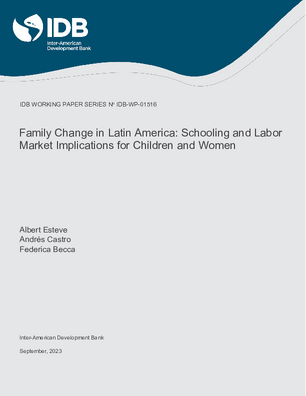Family Change in Latin America: Schooling and Labor Market Implications for Children and Women
Date
Sep 2023
This chapter provides an account of the major family transformations that occurred in recent decades across Latin American and Caribbean countries and examines the implications of such transformations for childrens school attendance and progress and womens labor force participation. Latin American and Caribbean families and households have undergone substantial changes in recent years while keeping some of their distinctive features unchanged (Esteve et al., 2022; Esteve & Florez-Paredes, 2018a; Juárez & Gayet, 2014). This combination of stability and change has had profound transformations in the family status in which women raise their children and the family context in which children are raised. We refer to family context as the combination of womens marital status and the type of households in which children reside. We combine references to the literature and own calculations based on Latin American and Caribbean population census samples, available at the Integrated Public-use Microdata Series International (IPUMS) (Minnesota Population Center, 2020). We use data from 25 countries based on the most recent census microdata and, in some instances, historical samples starting in the late 1950s (see Appendix 1).
The chapter is organized as follows. First, we document trends in family change and childrens status. To illustrate family change empirically, we focus on women aged 25 to 29 and children aged 7 to 16. For reasons that will be displayed during the paper, these groups offer a reliable overview of major transformations with the advantage of avoiding overlapping cohorts when data are analyzed over time. Variations by educational attainment are also examined to illustrate the role of inequality of opportunities in family change. Second, we focus on the implications of family forms on children's school attendance and progress and women's participation in the labor market. In the absence of tailored indicators about progress in cognitive and non-cognitive skills, school attendance and progress are standard indicators of early human capital accumulation (UNESCO, 2022). We examine these two outcomes among more than 15 million children included in the IPUMS-I census samples. For women, we examine the degree of participation in the labor market (n 16 million).
The chapter is organized as follows. First, we document trends in family change and childrens status. To illustrate family change empirically, we focus on women aged 25 to 29 and children aged 7 to 16. For reasons that will be displayed during the paper, these groups offer a reliable overview of major transformations with the advantage of avoiding overlapping cohorts when data are analyzed over time. Variations by educational attainment are also examined to illustrate the role of inequality of opportunities in family change. Second, we focus on the implications of family forms on children's school attendance and progress and women's participation in the labor market. In the absence of tailored indicators about progress in cognitive and non-cognitive skills, school attendance and progress are standard indicators of early human capital accumulation (UNESCO, 2022). We examine these two outcomes among more than 15 million children included in the IPUMS-I census samples. For women, we examine the degree of participation in the labor market (n 16 million).




